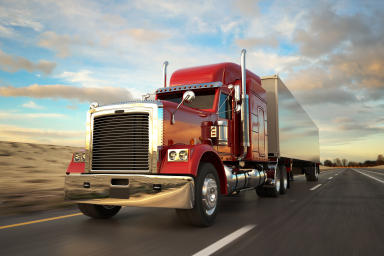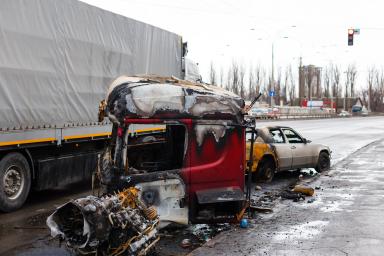Vermont is known for its thriving tourism, manufacturing, and agriculture industries, which have components that rely on trucking operations. In line with this, there is a significant amount of trucking traffic caused by Interstates 89, 91, and 189, which all connect the state with its neighbors.
In 2022, there were more than 160 accidents involving large trucks in Vermont, which brought about over 70 injuries and at least nine fatalities. Evidently, incidents involving vehicles of considerable size can have devastating consequences.
These road mishaps can occur for various reasons, including driver error, equipment failure, and unsafe road conditions. Whatever the cause, injured victims may be entitled to compensation for their injuries and other damages they have incurred.
If you or a loved one has been involved in a truck accident in Vermont, it is essential to seek the guidance of a skilled and experienced truck accident attorney who can help you understand the state's laws and fight for your rights. A qualified lawyer can assist by investigating the accident, collecting evidence, negotiating with insurance companies, and representing you in court, if needed.
Vermont Commercial Driver’s License Law
Truck drivers transport goods across the country and keep supply chains moving. However, operating a commercial motor vehicle (CMV) can be dangerous. To regulate the industry and help prevent accidents, the Vermont Department of Motor Vehicles (DMV) requires commercial drivers to have a commercial driver's license (CDL).
To obtain one, an individual must meet specific eligibility requirements and pass several tests as set forth by the state and the Federal Motor Carrier Safety Administration (FMCSA):
Must be at least 21 years old to operate a CMV across state lines or transport hazardous materials.
Must have a valid driver's license and meet certain medical requirements.
Must pass written knowledge and skills tests to demonstrate their ability to operate a CMV safely.
After obtaining a CDL, a truck driver is expected to follow the laws surrounding commercial vehicle operation, such as:
Adhering to hours of service regulations, which cover the time one spends on and off duty.
Complying with federal regulations governing the transportation of hazardous materials.
Driver fatigue, improper loading, and equipment failure are among the leading causes of truck accidents. By following state and federal rules, CDL holders can maintain the safety of roadways.
Vermont's Commercial License Classes
There are three CDL classes, which are based on the type and weight of the CMV a driver will be operating.
Class A CDL: This is required for drivers who operate a combination of vehicles weighing 26,001 pounds or more, where the towed vehicle is over 10,000 pounds. Vehicles requiring a Class A CDL include tractor-trailers, truck and trailer combinations, and livestock carriers.
Class B CDL: This is required for drivers who operate a single vehicle weighing 26,001 pounds or more or a combination of vehicles weighing less than 26,001 pounds, where the towed vehicle is less than 10,000 pounds. Vehicles requiring a Class B CDL include delivery and dump trucks.
Class C CDL: This is required for drivers who operate vehicles that do not fall under Class A or Class B but are designed to transport 16 or more passengers, including the driver, or transport hazardous materials in quantities that require placarding. Vehicles requiring a Class C CDL include small hazmat trucks.
Vermont Trucking Size and Weight Regulations
Vermont has size and weight regulations for trucks and other CMVs to promote safety and protect the state's infrastructure.
On highways, 80,000 pounds is the maximum weight allowable for trucks, with exceptions for certain vehicles or loads requiring special permits. Meanwhile, the general rules in terms of size limits include the following:
There are also limits for axle weight, which refers to the weight supported by each axle on a truck, to prevent damage to roads and bridges and reduce the risk of accidents caused by overloading:
These limits apply to all trucks operating on Vermont's roads and highways, regardless of whether they are registered in the state or elsewhere.
Special Excess Weight Permits
Vermont has established special excess weight permits for trucks that exceed the state's weight restrictions. The cost of a permit depends on its duration and the weight of the vehicle. The DMV may also require a bond or other security to ensure the permit holder complies with all applicable laws and regulations.
It's important to note that this type of permit is not issued for vehicles that exceed Vermont's size limits or for loads that exceed the legal height or width restrictions.
The fines for carrying overweight loads without a permit are based on the load weight and the distance it is traveling. For example, $15 should be paid per 1,000 pounds for the first 5,000 pounds overweight. Additionally, the fine schedule is doubled if a vehicle with a 99,000-pound permit is grossly overweight by more than 10,000 pounds. Refusal to remove the overload or submit a vehicle to weighing may result in a fine of up to $2,500.
More information on special excess weight permits can be found on the Vermont DMV website.
Vermont Hours of Service Regulations
In Vermont, there are rules on hours of service for truck operators based on federal regulations set by the FMCSA. Truck drivers are subject to the following:
11-hour driving limit: Truck drivers may not drive for more than 11 consecutive hours after 10 consecutive hours off duty.
14-hour driving limit: Truck drivers may not drive beyond the 14th consecutive hour after coming on duty, following 10 consecutive hours off duty. Off-duty time does not extend the 14-hour period.
Rest breaks: Truck drivers must take a rest break of at least 30 minutes after eight consecutive hours of driving.
60/70-hour limit: Truck drivers may not drive after being on duty for 60 hours in a seven-day period or 70 hours in an eight-day period. They can restart the 60/70-hour period by taking 34 consecutive hours off duty.
Sleeper berth provision: Truck drivers using a sleeper berth must take at least eight consecutive hours in it, plus a separate two consecutive hours either in the sleeper berth or off duty.
These regulations apply to all CMV operators involved in interstate commerce, regardless of whether they are registered in Vermont or another state. In addition, they must keep accurate records of their hours of service using a logbook or electronic logging device. Failure to comply with these rules can result in fines, vehicle impoundment, or even disqualification from operating CMVs such as trucks.
Vermont Trucking Speeding Law
All vehicles, including trucks, are subject to specific speed limits in Vermont based on the type of roadway they are traveling on. These include the following:
Truck drivers must obey the posted speed limits and adjust their speed based on road and weather conditions to prevent accidents and avoid fines. Additionally, trucking companies should prioritize safety by enforcing safe driving practices and providing ongoing training for their drivers.
Vermont Trucking Drunk Driving Law
There are strict regulations prohibiting truck drivers from driving under the influence of alcohol or drugs (DUI) based on Vermont’s Drunken Driving Law.
It is illegal to drive a vehicle while under the influence of any controlled substance, including prescription medications. A CDL holder — such as a truck driver — found attempting to operate or currently driving or controlling a vehicle with any amount of alcohol in their system will face penalties, including being immediately placed out-of-service for 24 hours.
Meanwhile, if a truck driver is found to have a blood alcohol concentration of 0.04% or more for the first time, they may face a fine of up to $750 and up to two years in jail. Subsequent offenses may lead to fines of up to $5,000 and imprisonment for up to 10 years. In addition, those convicted of DUI may lose their CDLs and be disqualified from operating a truck for a period of time.
By complying with these regulations and taking steps to prevent drunken driving, trucking companies and drivers can help ensure the safety of Vermont's roads for everyone.
Vermont Commercial Trucking Insurance Requirements
Truck operators in Vermont are required to carry the state’s minimum liability insurance coverage, including $25,000 per person and $50,000 per accident for bodily injury, as well as $10,000 for property damage.
Additionally, the FMCSA has established minimum liability limits for commercial vehicles depending on the cargo, like $750,000 for vehicles transporting non-hazardous materials and $5,000,000 for those transporting hazardous materials. Possible add-ons include unidentified trailer, cargo, workers’ compensation, and uninsured and underinsured motorist insurance.
These coverages are in place to protect not only the driver but also other road users in the event of an accident. Therefore, trucking companies and owner-operators should work with their insurance provider to ensure they have adequate coverage that meets state and federal requirements. It is also recommended that drivers and companies carry higher amounts of coverage to protect themselves against potentially large damage awards in the event of an accident.
How Much Can Someone Sue for a Truck Accident in Vermont
The amount a victim can pursue in a truck accident case in Vermont is based on the damages they have incurred. The state follows a fault-based system, which means the party responsible for the accident is liable for the resulting damages.
Damages can be economic, which refers to actual financial losses such as medical bills, lost wages, and property damage. They can also be noneconomic, which pertains to non-monetary losses like mental anguish.
There are no monetary limits on economic or noneconomic damages if the accident was caused by another person. However, the law imposes caps on claims against the state at a maximum of $500,000 per person and $2 million per accident.
You may need to consult with an experienced truck accident attorney if you have been involved in a truck accident to determine the appropriate legal strategy and seek maximum compensation for your damages.
Vermont Statute of Limitations for Truck Accidents
The statute of limitations for truck accidents in Vermont is three years, meaning the injured individual has a three-year period from the date of the accident to file a lawsuit and seek compensation for any damages they have sustained.
If they do not pursue legal action within the timeframe, they may lose their rights to seek compensation. Therefore, it is crucial to act quickly to ensure their rights are protected. It should also be noted that the statute of limitations may change for claims against government entities or those involving wrongful death.
Vermont Is a Fault State for Insurance Claims
Vermont is a fault state for insurance claims related to truck accidents. This means the party at fault is responsible for paying the damages the other party has suffered. These damages can be paid through the truck’s liability insurance policy.
Vermont Is a Modified Comparative Negligence State for Trucking Accident Lawsuits
Vermont follows a modified comparative fault law for determining fault in personal injury cases, including truck accident lawsuits. If a plaintiff is found to be partially at fault for an accident, damages will be reduced in proportion to their degree of fault. For instance, being 25% at fault for an accident means having the same percentage deducted from one’s damages. This translates to a final compensation of $75,000 if one is originally awarded $100,000.
Additionally, since the state follows a 51% rule, a plaintiff can recover damages from the defendant as long as they are not 51% or more at fault for the accident. If the plaintiff is found to be 51% or more to blame, they will be barred from recovering any damages.
Average Settlement for Vermont Trucking Accident Lawsuits
It is difficult to determine the average settlement for truck accident lawsuits in Vermont since many elements are taken into account when determining the value of a case. These include the amount and types of damages, as well as one’s percentage of fault. Hiring a lawyer who works on a contingency basis will also affect the total amount a plaintiff can take home.
Since each case is unique, consulting with a personal injury attorney experienced in truck accidents can provide you with a better understanding of your case’s value.
Legal Resources for Vermont Trucking Accident Victims
Vermont Bar Association's Lawyer Referral Service
This is a directory for injured victims seeking legal assistance after a truck accident. It helps people search for attorneys in Vermont who specialize in personal injury cases, including those involving truck accidents.
VTLawHelp Pro Bono Legal Service
The Vermont Bar Association's Pro Bono Legal Services program provides free legal assistance to low-income individuals and families who are unable to afford an attorney. The program matches eligible clients with volunteer lawyers who offer representation in a variety of areas, including personal injury cases related to truck accidents.
Vermont Legal Aid
Vermont Legal Aid is a nonprofit organization that assists low-income individuals, including truck accident victims, who cannot afford to hire an attorney. Its team of experienced lawyers can help injured people understand their legal rights, negotiate with insurance companies, and represent them in court, if necessary
Vermont Motor Carrier Safety Regulations Guide
The Vermont DMV Motor Carrier Safety Regulations outlines the rules and regulations governing commercial trucking in the state. These are designed to promote safety on local roadways and protect the public from the dangers of truck accidents. If you have been involved in a truck accident in Vermont, it may be important to understand these and how they may apply to your case.
Vermont CDL Manual
The Vermont CDL Manual is a valuable resource for truck drivers operating in Vermont. It contains information on safe driving practices, vehicle maintenance, and state and federal regulations. If you have been involved in a truck accident in Vermont, you may find the information in the manual useful in determining if the truck driver or company violated any safety regulations at the time of the incident.
Vermont Road Weather Information Stations
The Vermont Agency of Transportation's Road Weather Information System provides real-time weather and road condition updates. These can be especially relevant for truck drivers, who may need to adjust their driving behavior based on existing conditions. Additionally, if you are a truck accident victim in Vermont, you may use the site to see if the road conditions during the time of your accident may have played a role in its occurrence.
Step into the world of Expertise.com, your go-to hub for credible insights. We don't take accuracy lightly around here. Our squad of expert reviewers, each a maestro in their field, has given the green light to every single article you'll find. From rigorous fact-checking to meticulous evaluations of service providers, we've got it all covered. So feel free to dive in and explore. The information you'll uncover has been stamped with the seal of approval by our top-notch experts.





